
Vol. 1, No. 7 Published by India China Division, Air Transport Command March 1, 1945
|
C-109 Is Only Plane Available
For Emergency Flight To Hospital
BY SGT. F. T. MONTELEONE
1347 BU, India - S/Sgt. John Lyons, Kalamazoo, Mich., medical section chief of an ASC detachment stationed near this ICD base, probably has the quick efficiency of the ATC's varied operations to thank for his life.
When Sgt. Lyons was stricken with severe stomach pains that doubled him up last Saturday night, Maj. George Allen, Oklahoma City, Okla., group surgeon, became worried.
Maj. Allen made a quick decision, deciding to utilize ICD resources here to get Lyons to a more fully equipped army hospital 103 miles away.
Gas Hauler Appears
Meanwhile Maj. George Isenhower, San Antonio, Tex., director of operations, had nothing going out of this base in the desired direction, nor was there a scheduled shuttle plane due in. But some 7,000 feet up in the dark night sky, a gasoline freighter was calling in for landing instructions after completing its tough China run.
With the ambulance as close to the ramp as safety regulations would permit parking it, Sgt. M. Brodsky, and Cpl. M. Weiner, both of New York City, operations clerks, and several P & T loaders were ready to help stow Lyons gently and comfortably into the ship.
The C-109 crew, just back after some 11 grueling hours over the Himalayas, was equal to the emergency. Lt. E. N. Burbage, Tahlequa, Okla., pilot; Lt. E. W. McCabe, Houston, Tex., co-pilot; Cpl. W. R. Reynolds, Fordyce, Ark., radio operator, and S/Sgt. M. H. Mills, Dayton, Ohio, aerial engineer, completed their mercy mission in 35 minutes flat.
Everything Clicked
Now resting comfortably after a delicate appendectomy, Sgt. Lyons is happy over the way "everything clicked for me."
"It was a beautiful piece of timing and quick planning," Maj. Allen declared later, "and both Sgt. Lyons and myself wish to thank the ATC sincerely."
Crew Walks Out, Finds Plane OK At China Base
After Four Airmen Bailed Out Pilot Righted Ship, Landed Safely
1347 BU, India - The walkout story of the crewmen who bailed out of C-109 No. 877 which later was righted and landed safely by the pilot, Lt. H. T. Cunningham, was revealed this week.
The crew reported in to a China station a little more than a week after the pilot. (HUMP EXPRESS, Feb. 22).
Got Chutes Mixed
Following the pilot's instructions they had left the ship, one by one. The bailout was not without incident. Sgt. Lee Roy E. Aldrich, Venice, Calif., student engineer, jumped with M/Sgt. Clarence M. Scott's 'chute. Aldrich, a 212-pounder, could fasten only the chest straps of the harness for the descent. When it came Scott's turn, after S/Sgt. Richard H. Stewart, Bloomsburg, Pa., radio operator, had jumped, his meager 140-pound bulk seemed lost in the large 'chute.
F/O Courtland E. Nielsen, Los Angeles, Calif., co-pilot, went last and waited to open his 'chute until he dropped level with the others, so they might hit the ground together. he sustained a sprained ankle when he landed.
After the descent several members of the crew looked around for the pilot. They inquired about him from the hill folk who indicated that only four men had left the ship.
Saw Their Plane
The second day, the four crew members got together and cast about for a way out of the mountains. Ably assisted by a Chinese officer, who gave them passports and maps, they made their way to a point on the Burma Road a week later.
From there they were taken to an airstrip in China where they learned for the first time that the pilot had safely landed the ship from which they bailed.
As they prepared for takeoff, they saw C-109 No. 877 on the line next to them back in service again.
Aircraft Tire Blows, Crew Lands Ship Without Injury
1330 BU, Assam - Just as a transport pulled up her gear over an airfield in China, the nose wheel tire blew, but the ship, already airborne, continued the trip over the Hump to her home base.
In the cabin F/O John E. Ferguson, pilot, and F/O Duard W. Murray, co-pilot, began to make plans for the landing. The radio operator, Pvt. James T. Ross, called the home tower to notify the operator of the emergency landing. Crew Chief Ralph Caletri checked the nose wheel and found the tire completely flat.
When the transport came into sight over her home base, the crash trucks and ambulances were ready. The pilots ordered the rest of the crew to the rear of the plane.
Then the main gear touched the runway. The big ship rolled along on two wheels, nose high, until she came almost to a complete stop. The nose, gently lowered, was hardly scratched. In 15 minutes engineering had changed the wheel and the ship was taxied into a revetment, ready for another trip.
Rest Leave Policy Set Forth in New ICD Hq Regulations
Hq., Calcutta - A regulation issued last week establishes a uniform policy for granting leaves, furloughs and temporary duty at rest camps.
All personnel may be granted a 15-day leave, furlough, or TDY each year, states the regulation, in so far as consistent with operational requirements.
Wing and base commanders are authorized to grant leaves and furloughs not in excess of 20 days including travel time, to visit points other than designated rest camps, with the restriction that personnel are not permitted to travel from India to China, nor from China to India, for this purpose.
Skillful Handling of Burning C-46 Saves Lives, Vital Cargo
1304 BU, India - First Lt. Gildo G. Previsian landed a C-46 here, literally in a blaze of glory Tuesday night. Previsian and his crew, all assigned to 1326 - 2nd Lt. Russell D. Brewington, co-pilot; Cpl. Vernon A. Kennedy, radio operator, and Pvt. Harold O. Addington, assistant radio operator - had run up their ship.
Finding that it checked out, they started the takeoff run, only to have an engine conk on the ground. Back they came, and the temperamental power plant received a working over.
Believing the trouble corrected, they ran the engines up again and took off. Suddenly, shortly after they were airborne, the engine cut again. Promptly Lt. Previsian feathered the prop, jus as an oil fire broke out in the nacelle.
Although the ship was fully loaded he managed to bring it around in the pattern, and "grease" it in on the runway. The ground crew hurriedly put out the fire. Net gain from the pilot's skillful flying - four lives, one C-46, one full load of vital military cargo.
Good Conduct Medals Now To Be Real Thing
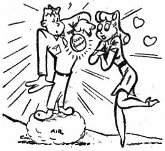
|
Hq., Calcutta - All you wallahs who are proud of your Good Conduct medals, take a seat near the tail because good-wallahs who are rewarded in the future are going to get Good Conduct MEDALS.
You see, that red and white jigger you're wearing (or aren't you?) is no medal whatever, but just a sort of label which testifies that you'd be entitled to a Good Conduct medal if there'd been any.
More than 3,000 of the real thing have been received at headquarters, according to the promotions and awards section of A-I. Distribution up to now has been confined to China Wing recipients, the section reports.
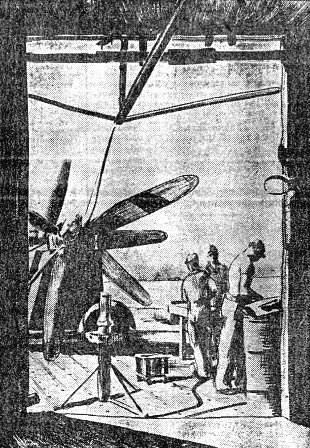 In this brush drawing, Capt. James P. Scott, ICD artist, has caught the work of the prop shop at an Assam base.
Overhead is a rail which carries the propellers from the outside dollies into the building. At the right is a
"cleaning table" at which a trio of GIs is working.
In this brush drawing, Capt. James P. Scott, ICD artist, has caught the work of the prop shop at an Assam base.
Overhead is a rail which carries the propellers from the outside dollies into the building. At the right is a
"cleaning table" at which a trio of GIs is working.
|
Personnel Gives Lowdown
On Service Star Eligibility
Hq., Calcutta - So many questions have been asked recently about who is eligible to wear the bronze service star, that the A-1 section has come forth with the malum on the subject.
There are three ways in which ICD personnel might qualify to wear the star: by being assigned or attached to certain bases given "battle credit;" by having served in ICD during December, 1943, and therefore being eligible to wear the star; by being assigned or attached to certain bases given "battle credit;" by having served in ICD during December, 1943, and therefore being eligible to wear the Distinguished Unit badge permanently; by serving "honorably" in a combat zone under competent orders.
In the latter category fall those who have received a combat decoration or a certificate from a corps or higher commander that they actually participated in combat and those who have served as a "normal post of duty" in a combat zone - as contrasted to those occupying the status of inspector, observer or visitor. Pilots or crew members participating in flight over a combat zone would be considered serving at a "normal post of duty."
There are only two campaigns for which ICD personnel may be given credit - the India-Burma campaign and the China campaign. Certain ICD units have received credit for participation in the India-Burma affair, but none has been given credit for the China campaign, according to personnel.
Following are the ICD base units considered in the I-B combat zone and awarded battle credit: 1327, 1328, 1329, 1330, 1332, 1333, 1337, 1338, 1339, 1340, 1342, 1343, 1344 and 1348.
Only one bronze service star may be worn for participation in any one campaign. Hence, an individual assigned to ICD in December, 1943, and also stationed at one of the "battle credited" bases, still may wear only one star, unless entitled to the star for two campaigns.
Radio Operator is Stuck with Miami, Yearns for India
1306 BU, Karachi - Pity poor M/Sgt. Maurice J. Scanlon. The guy doesn't have a priority. But before your tears flow too freely, better hear his story.
Scanlon, veteran radio op and radio briefing NCO here, needs the priority back from Uncle Sugar !
He left his own station here on a briefing route survey trip for Accra, in Africa, his orders reading in the usual manner, "Subject EM will return to his proper station upon completion of the mission."
But in Accra, radio operators were so scarce that he was shanghaied for an additional flight straight on to Natal, in Brazil. And there yep, you've guessed it! Operators were scarce again, and he was sent on to Miami.
Now he's languishing on the sands, while priority radiograms flit back and forth 'cross half the globe, as officers try to help the "poor guy" out and get him back to his station.
Expertly Secured Cargo Spares Aircrew Disaster
1348 BU, Burma - An on-the-ball priorities and traffic section paid this airbase a heavy dividend one recent day when a freshly-loaded C-47 made a crash landing after takeoff and not one drum in its load of gasoline was moved out of place.
To Maj. Winfield C. Clarke's P & T men, it was just a routine loading job. But to the crew of the
 Here is the picture story of a belly landing that might have been a catastrophe, but which a bang-up job of plane
loading turned into a triumph. Top, a C-47 rests on its belly after a crash landing following a take off in
which both engines quit. Bottom, an interior view shows the perilous cargo of gasoline intact, not a drum
budged by the jolt of the landing.
Here is the picture story of a belly landing that might have been a catastrophe, but which a bang-up job of plane
loading turned into a triumph. Top, a C-47 rests on its belly after a crash landing following a take off in
which both engines quit. Bottom, an interior view shows the perilous cargo of gasoline intact, not a drum
budged by the jolt of the landing.
|
Both the 47's engines cut out just as it was airborne. Such a landing, with such a cargo, often has resulted in disaster. But this time the securely tied load was undisturbed by the impact.
Tie-down heroes of the escape were Sgt. Cleddie A. Keith, of San Saba, Tex., who had supervised the loading of the plane, and Pvt. Haze Hatfield, of Phoenix, Ariz., who had laced the drums.
The crewmen got out of the plane with perspiration on their foreheads and thanks on their lips.
GIs Mob New PX at 1347
To Get Beer, Smokes, Other Items
1347 BU, India - On, on into the night the long line of beer and smoke hungry GIs here sweated out the first PX line on opening day. Cpl. R. E. "Bob" Thompson, former real estate operator of West Palm beach, Fla., now PX sales wallah, was heard to mutter between sales, "Boy, oh boy, if them tide-flats in Florida only moved like this beer!"
The first ration consisted of 12 cans of beer, one carton of cigarets, one cigar, and several miscellaneous items such as stationery, matches, ink, and candy - one to a man. Total sales the first day amounted to Rs. 8,500.
T/Sgt. T. R. Wells, of Long Beach, Calif., and S/Sgt. C. W. Brown, of Russellville, Ala., charged with doing the book work on the PX sales, are looking forward eagerly to completion of the permanent PX quarters so they can transfer their activities from the tops of packing boxes to more efficient quarters.
Air Raid Gags Chase Men into Cover at Bases
Abbott, Costello Comedy, Voice Over Speaker Causes Trouble
Two air raid gags filtering in from the field this week carried on the tradition of foolish alarms initiated at the 1337 BU more than a year ago by Laurel and Hardy, when some of their over-realistic air raid sound effects catapulted some nervous neighbors of the GI cinema palace into slit trenches.
One was another funnyman movie deal, and the other, a freak-up of the base loudspeaker system.
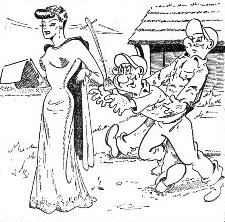 "Come on, it's only a mirage."
"Come on, it's only a mirage."
|
When Abbott and Costello moved into one ICD base last week with their latest madness, "In Society," S/Sgt. Frank Sherman, of Brockton, Mass., was too deep in a 5-R stud game to attend the opening night performance. He minimized the attractions of the movie so convincingly that T/Sgt. John Jordan, of Auburn, Me., and S/Sgt. Dennis Mowchan of Elmira, N.Y., decided to give him a chance to break even.
About an hour later Sherman leaped to his feet, "Say, wasn't that a siren I heard?"
The rest of the boys were on their feet, too. They listened hard. Sure enough, it was.
They called the operator - he didn't know a thing. They called the provost marshal - neither did he.
"Well, we'd know if it was an air raid," Jordan said, hopefully. "They'd call us up."
He almost swallowed his teeth right then and there, as the phone rang. But the voice at the other end had the real dope on the situation, and it was harmless enough. Abbott and Costello had got a hold of a fire truck and were sirening all over the place, and the soundman had turned it up a little too loud.
In the week's second version of the old story, it was an effort to round up a group of Chinese passengers for a waiting plane that caused the damage. One of the Chinese was requested to page his colleagues in Chinese over the loudspeaker, and quite a turmoil followed his few words of maudlin Mandarin before it was explained to a few jittery people around the terminal that it was NOT a Jap invasion.
That, at least, is the way the story was told this week.
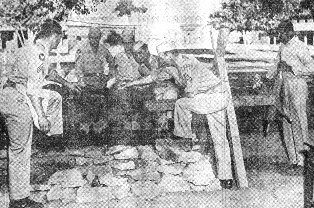 1306 BU, Karachi - barbecuing a pig in India is a far cry from doing the same thing in Texas or California,
but the GIs above seem to be making the transition with ease. Above, left to right, Sgt. Roy D. Smith, of Clarksburg,
W.Va.; Sgt. Curtis Peterson, Richmond, Calif.; T/Sgt. Henry Davinsizer, Bellwood, Pa.; Pvt. Joseph Guerrico, Hopedale,
Mass., and Sgt. Edward Mai, Dallas, Tex. The boys had their fun roasting the "beast," but the outcome was sad.
1306 BU, Karachi - barbecuing a pig in India is a far cry from doing the same thing in Texas or California,
but the GIs above seem to be making the transition with ease. Above, left to right, Sgt. Roy D. Smith, of Clarksburg,
W.Va.; Sgt. Curtis Peterson, Richmond, Calif.; T/Sgt. Henry Davinsizer, Bellwood, Pa.; Pvt. Joseph Guerrico, Hopedale,
Mass., and Sgt. Edward Mai, Dallas, Tex. The boys had their fun roasting the "beast," but the outcome was sad.
|
GIs Enjoy (?) a Barbecued Pig
Spend 5 Hours Roasting Boar Over Open Spit - For What ?
1306 BU, Karachi - As barbecued pig is not one of India's native dishes, GIs passing the Red Cross club here one day last week stared in amazement at the sight of five enlisted men tenderly ministering to the needs of a boar on a spit, being turned by an Indian bearer.
The wild boar was shot with a 1903-type army rifle about 75 miles from Karachi. The hunters, all of whom work in base utilities, were T/Sgt. Henry Davinsizer, Bellwood, Pa.; Sgt. Edward Mai, Dallas, Tex.; Sgt. Curtis Peterson, Richmond, Calif.' Sgt. Roy D. Smith, Clarksburg, W.Va., and Pvt. Joseph Guerrieo, Hopedale, Mass.
5-hour Barbecue
All had done some hunting in civilian life, but this was the first boar for any of them. After skinning and cleaning the animal, they built a spit and a fireplace on the lawn of the Red Cross club. Smith, who admitted to having been present at a barbecue once, took over as number one chef by virtue of this eminent experience. The medics examined the pig which came through with a clean bill of health. The barbecue started about 5 p.m. and went on until nearly 10 p.m.
Supper on Veranda
The strange activities soon drew a crowd. As the evening wore on and the fragrance of roast pig was wafted about, the number of spectators and potential eaters grew. So did the hunger and excitement of the five hunter-cooks. Shortly before 10 p.m. they decided to cut down the animal and start the serious business of eating. For the occasion, Red Cross chefs rustled up bread and coffee and several tables for a buffet supper on the veranda.
But here's the rub: the first bites of what was to be succulent pig, proved beyond doubt that the five hours of barbecuing had had little effect on the tough boar.
The hunters haven't given up boar hunting, but they have agreed to do their quarry up a bit browner next time.
Survive Rocky Journey Over Old Rock Pile
Radio Failure, Fire, Only Beginning of Crew's Misfortunes
1330 BU, Assam - Unscathed and feeling pretty lucky as they returned here, members of an aircrew related an incredible tale of misfortunes encountered during a Hum flight.
Somewhere over the Himalayas the command and liaison radio transmitters went out. At about the same time No. 2 engine caught fire. Lt. Joseph G. Vacek, pilot, and F/O John E. Ferguson, co-pilot, extinguished the fire and started to feather the prop.
Contact Impossible
The ship began to lose altitude and the pilot instructed T/Sgt. John E. Burris, crew chief, to jettison the cargo. When Burris grabbed the cargo door handle it sheared off, making it impossible to open the door and drop the load.
To further complicate matters, No. 2 prop refused to feather and remained in the low pitch position, increasing the drag. Radio Operator Edward Korpita reported that it was impossible to contact the landing field.
Crew Gets Out "OK"
Once near the field, a growing snow storm all but blinded the pilots and the radio silence continued. As they made their approach the wheels and wings grazed tree-tops which suddenly loomed out of the storm.
Making a quick pull-up they took two more turns and at last the ship settled down on the runway. The crew was evidently none the worse for the hectic hours over the Hump.
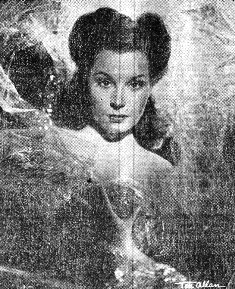 This is Carol Thurston, the girl we would most like to shake hands with if we were left-handed. Carol is said
to be very proud of her American pioneer background. We prefer the foreground. She will be seen in RKO
Radio Pictures.
This is Carol Thurston, the girl we would most like to shake hands with if we were left-handed. Carol is said
to be very proud of her American pioneer background. We prefer the foreground. She will be seen in RKO
Radio Pictures.
|
1347 BU Completes 48 Days of
Hump Operation Without Mishap
As It Contributes to Records
Several Hundred Trips Flown Without Accident Since Jan. 9, When
Station Was Started; Maj. Ware, Veteran Hump Pilot, Now CO
1347 BU, India - Without accident or mishap to mar its record, this new ICD station completed 453 round trips over the Hump in its first 48 days of existence.
Starting Jan. 9, under the command of veteran Hump pilot Maj. Joseph C. Ware, Jr., Birmingham, Ala., growth of the station has been rapid. It played its part in the record-breaking January tonnage moved by ICD to China, and since the first of February has increased its share in the over-all movement.
Clock-like Regularity
In analyzing his station's performance, Maj. Ware gave credit for the excellent performance to full coordination between operations, P & T, and production line maintenance. Flying safety is stressed constantly at this new base unit, too, and the spotless accident record reflects the importance of the work done in the field.
Today, planes are flying the Hump to China with cargo for Americans and local troops with a regularity that is clock-like. Full February figures will show an increase for the station of more than 300 percent over a similar period in January, it is estimated.
Hope for More Records
Tonnage, of course, can't be revealed, but every man on the base watches the figures daily, and each day tries to beat yesterday's performance.
A compact pattern of smoothly-functioning departments is evolving from the chaos which always accompanies the opening of a new base, and Maj. Ware and his men hope this station will continue to set safety records as physical facilities improve and each man gains experience in his job.
Nose of Washed-out Plane Is Fine Projection Booth
1348 BU, Burma - This base claims one of the most unusual projection booths in all GI moviedom - the nose of a cracked-up C-47, with the flicker beamed through the raised hood.
The idea is as practical as it is novel. The unit's new projector is now immune to the Burma weather, and while the audience may get a little wet out front, the film and projectionist remain as dry as a China beer ration.
The cinema pilot, T/Sgt. James H. Haines, Cumberland, Md., is mainly responsible for the new wrinkle. The rotund chief projectionist, "promoted" the front segment of the wreck and then fitted it out according to plans of his own devising. "Spring Chicken" is the moniker of the re-commissioned Skytrain.
A motion picture operator in civvies too, Haines has been changing reels for 11 years. He arrived in the CBI area last December and the 1348 BU is his first station.
Haines says of the booth, "I'm just waiting to see some pictures of better ones, that's all." (See photo below)
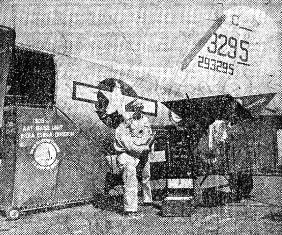 This "fleet service" trailer has just been placed in operation at 1305 BU, Calcutta, to cut down intermediate airline
stopping time by putting all the service eggs in one basket. Maj. Clyde H. Cartwright, Pittsburgh, Pa., P & T
director at 1305, (left) is demonstrating the device to Lt. Col. Clayton Joyce, CO. The loading platform at the
left is another new Stateside wrinkle developed at the base.
This "fleet service" trailer has just been placed in operation at 1305 BU, Calcutta, to cut down intermediate airline
stopping time by putting all the service eggs in one basket. Maj. Clyde H. Cartwright, Pittsburgh, Pa., P & T
director at 1305, (left) is demonstrating the device to Lt. Col. Clayton Joyce, CO. The loading platform at the
left is another new Stateside wrinkle developed at the base.
|
New 'Fleet Service' Enhances Passenger Comfort on Aircraft
ICD's new "fleet service" can't quite boast everything from soup to nuts, but the new catering device just placed in operation at 1305 BU, Calcutta, does a good job of substitution.
The new gadget, in the form of a two-wheeled trailer pulled by a "tug," combines some of the functions of three departments - supply and service, priorities and traffic, and aircraft maintenance.
Contents of the fleet service trailer include just about everything required to enhance the passenger's comfort - blankets, magazines, clean seat covers, K-rations, plates and cups, thermos jugs, fruit juices, aerosol bombs, mop, broom and even toilet paper.
The trailer was devised to shorten intermediate stops at bases throughout ICD to less than half an hour. When a plane lands, the fleet service crew - with the aid of its loaded trailer - sets to work sweeping out trash and dirt, mopping the floor if necessary, replacing soiled seat covers, furnishing blankets and replenishing the ship's larder.
Another step in ICD's plan to give airline passengers service as near Stateside as possible, the fleet service development is an adjunct to the conveniences offered by flight traffic clerks who dispense reading material, cold and hot drinks and otherwise make passengers comfortable during flight.
|
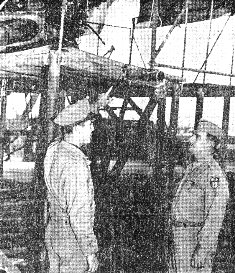 Lt. Col. Charles F. Skannal views new crew chief stand built and put into use by the engineering department at 1333,
as Capt. Charles H. Murray, director of aircraft maintenance, explains its use. The stands, which are portable
nose hangars, cost the government one fourth the price of a standard hangar, and are much more practical. As CO,
Col. Skannal, an airman of long standing, takes a keen interest in what happens "on the line."
Lt. Col. Charles F. Skannal views new crew chief stand built and put into use by the engineering department at 1333,
as Capt. Charles H. Murray, director of aircraft maintenance, explains its use. The stands, which are portable
nose hangars, cost the government one fourth the price of a standard hangar, and are much more practical. As CO,
Col. Skannal, an airman of long standing, takes a keen interest in what happens "on the line."
|
United Airlines Transport Pilot Now CO at 1333
Skannal Has 14,000 Air Hours To His Credit; Flies All Type Ships
1333 BU, Assam - At its largest base in Assam, ICD has placed a pilot with plenty well-rounded experience as commanding officer.
He is Lt. Col. Charlie F. Skannal, whose flying record lists 14,000 air-hours amassed over a period of 15 years.
In that time Col. Skannal has flown fighters, bombers and civilian and army transports in every corner of the world.
The colonel started his flying career after graduation from Georgia Tech (where be obtained a BS degree in electrical engineering) when he was commissioned in the Air Corps reserve in 1928. He then went to Kelly Field, Texas and earned his wings in February, 1930. After 18 months active service with a combat group, he engaged in private flying and took a job with United Airlines in 1933.
The outset of the war found the airman a captain with United's Eastern division. In May, 1942, he was recalled to active duty by the army and was placed on military leave by the airlines.
A month later he went to Santa Monica, Calif., to attend the first C-54 operational training school conducted by Douglas Aircraft for the Army. From there he was transferred to ATC Hq in Washington, D.C. He was assigned to the operations section and later was director of aircraft operations of a division of ATC.
From the nation's capital, he took part in the planning of many of ATC's special mission flights made by high government and Army officials. He flew long-range, four-engine aircraft for such high rankers as Gen H. H. Arnold and Lt. Gen. B. H. Somervell. He was a crew member on one of these flights which established a time record from Australia to Washington, D.C.
Before coming to India, the Louisiana-born flier was ATC's operations officer for the Caribbean wing.

|
At Unique Aircraft Factory  Proof that the Indians working at Hindustan Aircraft, Ltd., are on the water wagon is contained in this photo
showing the ox-drawn tank wagon which hauls aqua to Indians overhauling ICD and other aircraft. Standing nearby
is a trio of old-timers in the business of repairing and rebuilding planes.
Proof that the Indians working at Hindustan Aircraft, Ltd., are on the water wagon is contained in this photo
showing the ox-drawn tank wagon which hauls aqua to Indians overhauling ICD and other aircraft. Standing nearby
is a trio of old-timers in the business of repairing and rebuilding planes.
|
Only Plant of Kind in India, Hindustan Aircraft,
Maintains Fountain of Youth for Planes
Collaboration Is Keynote in Three Agencies' Work of Repair
1309 BU, Bangalore - Two thousand hours over the Hump battling rain and ice, flying through punishing winds, and straining in the clutches of downdrafts are enough to put the death rattle into the best ATC plane.
A-I evidence of that was "Weight Lifter," a tired old C-47 that bounced in to a rough landing here, then limped back to park in front of the engineering tent. The engines wheezed and coughed. The control cables needed to be replaced. Months of operation had thrown the landing gear out of alignment. And in the air the ship vibrated like a Model-T on a corduroy road.
Fountain of Youth
Yet, a few weeks later, "Weight Lifter," completely rejuvenated, happy hum to its engines, sped down the runway and nosed back towards its home station. Once again it was ready for service over ICD's aerial supply route.
The story of what happened to that C-47 at this airbase is the story of co-operation between the ATC, the ASC and the Indian government. It is here that the only factory of its kind in all of India - Hindustan Aircraft, Ltd. - maintains a mechanized version of Ponce De Leon's Fountain of Youth, where thousands of hours of service are added to Allied aircraft.
From bases all over India and China planes are brought here for repair and maintenance work. But the actual job of rebuilding these war-weary craft begins, strangely enough, hundreds of miles from Bangalore. The first of the interlocking chain of ATC-ASC operations which make this possible takes place at the base where the plane is picked up by an ATC crew.
Towed to Operating Room
Immediately after takeoff the crew members begin a careful check to determine weakness in the plane. By the time the flight reaches the aircraft factory here, the men have accumulated valuable information for the engineering officer.
Next step is a check on the ground to determine what other repairs are necessary. With the report supplied by the ferrying crew, plus the operational history of the ship from the home base, Capt. Frank Alleva's ATC engineers have an X-Ray-like picture of the ship. After they make minor repairs, they pass their findings on the more serious ailments along to the ASC engineering section.
From there on the plane's fate rests squarely in the hands of the specialists of that command. The ship is towed to the "Operating Room," the court between two of the Hindustan factory hangars, where Indian and American civilian employees confer with ASC experts. The reports from the home base and those from the ATC engineering section are studied, and final decisions are made for "recreating" the ship.
Occasional Sticklers
Indian workers then swarm over the plane, and the work begins. In a matter of weeks most repairs are accomplished. Then ASC test pilots put the plane through its paces and if it meets with their approval, they okay it for return to its home base. In the case of all ATC aircraft, test hops are made by ICD pilots Capt. Robert Havey and 1st Lt. Earl Schmeling, before a final acceptance okay is put on any plane.
Occasionally a tough problem remains unsolved even after much work in the factory. Two weeks ago an ATC cargo ship from a Valley station continued to create vibration despite every effort of factory employees to locate the source of the trouble.
An immediate consultation was called between ASC and ATC engineers. After hours of sweat and grease, they climbed out of the plane with a "nay malum" shake of their heads. The big cargo carrier remained a sick patient.
Trade Schools Set Up
Then test pilots from both commands took the ship up for a hop in a continued search for the trouble. Finally, at the end of two days experiment, the cause of the vibration was located. The work was completed and once again ATC-ASC cooperation had paid dividends and another plane was back into operation in the war against the Japanese.
The Hindustan Aircraft factory, where the actual repair work is done, was constructed in 1940. Two years later it began its program of maintenance of American, Dutch and RAF aircraft. When the entire enterprise was placed under USAAF control in 1943, the ASC was assigned the task of training 13,000 Indian employees.
To lick this problem, trade schools were set up and each man was taught a specific operation of the type used on American production lines. Residents of Mysore state, in which the factory is located, proved themselves mechanically minded. They learned quickly, and working under ASC direction, were soon repairing planes faster than they could be flown back to their home bases.
Cooperation
One year ago ATC came to the rescue by establishing a base here for the purpose of ferrying war-weary ships to the field and taking the repaired ones back. At first there were only a handful of officers and enlisted men assigned to the task, but as the war effort in this theater assumed greater statue, more personnel and better facilities were added. At present this base - under ASC's commander, Col. Melville C. Robinson, and the ATC commander, Maj. A. W. Patterson, Jr. - is handling all higher echelon repair for ICD's C-47s and C-87s.
Cooperation between the commands has drawn the attention of high ranking Army officers.
 Scrutinizing work of a pair of Hindu craftsmen at the aircraft factory is 1st Sgt. Van Horn, the first GI to arrive
for duty at the ICD installation at Bangalore just a year ago.
Scrutinizing work of a pair of Hindu craftsmen at the aircraft factory is 1st Sgt. Van Horn, the first GI to arrive
for duty at the ICD installation at Bangalore just a year ago.
|
 Here two GIs of ICD supervise the efforts of an Indian mechanic as he works on a transport engine out under the
sun near one of the hangars of the aircraft plant which revitalizes ICD work horses. The worker is dismantling
the power plant.
Here two GIs of ICD supervise the efforts of an Indian mechanic as he works on a transport engine out under the
sun near one of the hangars of the aircraft plant which revitalizes ICD work horses. The worker is dismantling
the power plant.
|
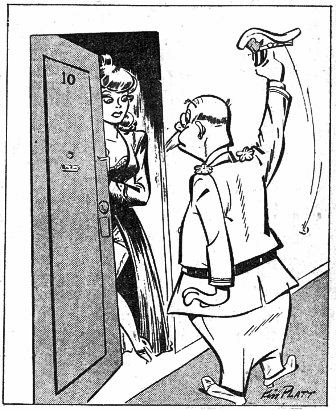 "Just checking up for the air inspector, Madame -
"Just checking up for the air inspector, Madame -Do you have any of our pilots?" |
1306 BU, Karachi - A new base record was established here this week for the loading of cargo and passengers by three enlisted men of P & T.
In a 50-minute period, 10,050 pounds of cargo were unloaded, while 4,000 pounds of baggage and 31 passengers were loaded.
S/Sgt. Paul Manclark, of Turtle Creek, Pa., worked on the cargo, with Pfc. Willard Schwatal and Pfc. Robert Verderer, both of Chicago, collaborating on the baggage loading.
Radio Operators Get Plaudit From Skannal
1333 BU, Assam - Lt. Col. Charlie F. Skannal, CO of this important Hump base, has this to say of ICD radio operators:
"The radio men flying the Hump day and night are men who have earned the respect and admiration of all ground personnel as well as that of their fellow airmen.
"The have played a vital role in helping to accomplish the mission of the ICD.
"Radio operators, many in the lower grades, are awakened at all hours of the night and hurried to their planes to help get another load over the Hump.
"Theirs is a role of toil and risk, and many have made the supreme sacrifice.
"They are the unsung heroes of this war - without glory, perhaps, but not without honor."
HUMP EXPRESS is the official newspaper of the India-China Division, Air Transport Command, APO 192, c/o Postmaster, New York, N.Y., and is published by its Public Relations office. Camp Newspaper Service and Army Newspaper Service features are used, reproduction of which is prohibited without permission of CNS and ANS, 205 East 42nd St., New York, 17, N.Y. Other material is submitted by staff members, ICD-ATC base Public Relations sections and other soldier correspondents. Printed weekly by the Hindusthan Standard, 3 Burman St., Calcutta, India, and distributed each Thursday. Passed by U.S. Press Censor for mailing.
| Military transport schedules over India for cargo, personnel and mail . . . maximum tonnage of essential war materials over the Hump . . . movement of troops and supplies in support of tactical operations in China . . . evacuation of the sick and wounded - these are the missions of ICD-ATC. |

MARCH 1, 1945
Original issue of HUMP EXPRESS shared by CBI veteran Steven C. King, author of Flying the Hump to China.
Copyright © 2006 Carl Warren Weidenburner
TOP OF PAGE PRINT THIS PAGE ABOUT THIS PAGE E-MAIL YOUR COMMENTS
PREVIOUS ISSUE HUMP EXPRESS BASE NEXT ISSUE
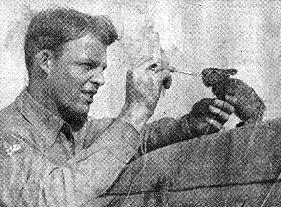 It's suppertime for the 1347 BU's pet baby rabbit, Peter Tare, and he takes his drop from an eye dropper manipulated
by Sgt. Bob Laurence, of Schenectady, N.Y. Evaporated milk is the piece de resistance. Pete was found in the jungle one cold day and adopted by the priorities and traffic section, from which he derived his name. ("Peter Tare" means P.T. in case your memory of the phonetic alphabet has deteriorated.) He was about two weeks old when the picture was taken - not a bit shy, and inclined to prefer snuggling in a pocket to living like a gentleman in the woods and straw hut provided for him by his adopters.
It's suppertime for the 1347 BU's pet baby rabbit, Peter Tare, and he takes his drop from an eye dropper manipulated
by Sgt. Bob Laurence, of Schenectady, N.Y. Evaporated milk is the piece de resistance. Pete was found in the jungle one cold day and adopted by the priorities and traffic section, from which he derived his name. ("Peter Tare" means P.T. in case your memory of the phonetic alphabet has deteriorated.) He was about two weeks old when the picture was taken - not a bit shy, and inclined to prefer snuggling in a pocket to living like a gentleman in the woods and straw hut provided for him by his adopters.

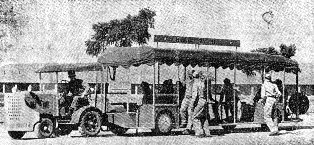 1306 - "Karachi Air Base KAB," perpetual motion shuttle bus built by ICD welders entirely from scrap, except for
the running boards. Men who built the KAB, reminiscent of N.Y. World's Fair, include S/Sgt. W. Carroll, Benton Harbor,
Mich.; Sgt. Jack Burt, Crystal Springs, Miss.; Cpl. Warren Rocole, Geneva, Neb.; Pfc. S. J. Carpenter, Houma, La.;
Pfc. Harold Doerle, New Iberia, La.; Pfc. Keith Huckelbury, Van Buren, Ark., and Pvt. John Brideau, Garner, Mass.
1306 - "Karachi Air Base KAB," perpetual motion shuttle bus built by ICD welders entirely from scrap, except for
the running boards. Men who built the KAB, reminiscent of N.Y. World's Fair, include S/Sgt. W. Carroll, Benton Harbor,
Mich.; Sgt. Jack Burt, Crystal Springs, Miss.; Cpl. Warren Rocole, Geneva, Neb.; Pfc. S. J. Carpenter, Houma, La.;
Pfc. Harold Doerle, New Iberia, La.; Pfc. Keith Huckelbury, Van Buren, Ark., and Pvt. John Brideau, Garner, Mass.
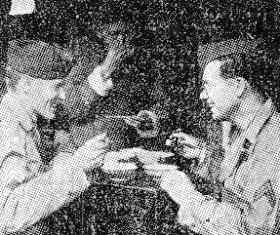 1344 - What does the average GI do during free time in China? Here's one of the answers, as T/Sgt. John Petro (left),
of Philadelphia, personnel clerk, and Cpl. Robert Laughlin, of Thomasville, N.C., statistical clerk, learn the ancient
art of eating with Chinese chopsticks.
1344 - What does the average GI do during free time in China? Here's one of the answers, as T/Sgt. John Petro (left),
of Philadelphia, personnel clerk, and Cpl. Robert Laughlin, of Thomasville, N.C., statistical clerk, learn the ancient
art of eating with Chinese chopsticks.
 1348 - Here in northern Burma, this cut-off nose of a cracked-up C-47 serves as a projection booth at the base
movie palace. T/Sgt. James H. Haines, chief projectionist, pre-flights the "Spring Chicken" before her maiden thriller.
1348 - Here in northern Burma, this cut-off nose of a cracked-up C-47 serves as a projection booth at the base
movie palace. T/Sgt. James H. Haines, chief projectionist, pre-flights the "Spring Chicken" before her maiden thriller.
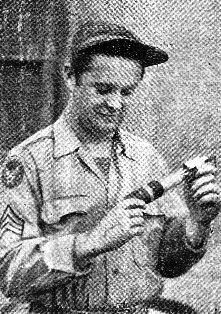 1344 - Sgt. Elwood F. Smith, of Secaucus, N.J., examines a Japanese anti-personnel bomb which fell harmlessly on
this base during a raid (Story of the raid was told in HUMP EXPRESS January 15). The bomb, crude and lightly
constructed, was one of several which fell near a B-29.
1344 - Sgt. Elwood F. Smith, of Secaucus, N.J., examines a Japanese anti-personnel bomb which fell harmlessly on
this base during a raid (Story of the raid was told in HUMP EXPRESS January 15). The bomb, crude and lightly
constructed, was one of several which fell near a B-29.
 1347 - Comparing medals are SWR (Sgt.) Kale Khan, left, formerly of the Indian Cavalry, and Pfc. Ray Montana, of
Oakland, Calif. The sergeant served with distinction in France during the last war, and later in 1935 on the Indian
Northwest frontier. He holds awards for gallantry in both periods of service. The Yank takes equal pride in displaying
his DFC and Air Medal.
1347 - Comparing medals are SWR (Sgt.) Kale Khan, left, formerly of the Indian Cavalry, and Pfc. Ray Montana, of
Oakland, Calif. The sergeant served with distinction in France during the last war, and later in 1935 on the Indian
Northwest frontier. He holds awards for gallantry in both periods of service. The Yank takes equal pride in displaying
his DFC and Air Medal.
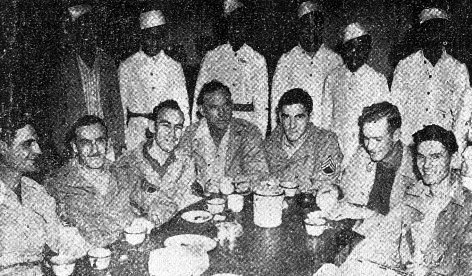 1311 - A total of 189 months overseas is represented by these seven Ohio soldiers, each with 27 months to his credit.
Left to right are M/Sgt. Everett Easter, Hamilton; S/Sgt. Richard M. Dougherty, Dayton; T/Sgt. Robert J. Snyder, Lucasville;
Col. Robert L. Dennis, Bremen; S/Sgt. James Doty, Springfield; Sgt. Albert L. Martin, Jackson and S/Sgt. Steven Kuzyk,
Cleveland - U.S. bound.
1311 - A total of 189 months overseas is represented by these seven Ohio soldiers, each with 27 months to his credit.
Left to right are M/Sgt. Everett Easter, Hamilton; S/Sgt. Richard M. Dougherty, Dayton; T/Sgt. Robert J. Snyder, Lucasville;
Col. Robert L. Dennis, Bremen; S/Sgt. James Doty, Springfield; Sgt. Albert L. Martin, Jackson and S/Sgt. Steven Kuzyk,
Cleveland - U.S. bound.
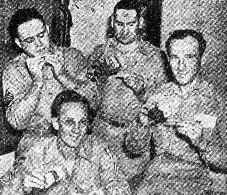 1333 - Cigaret shortage in Assam and W/O Obrey Evans, Clarksville, Texas, leads the way with pipe tobacco and cowboy
roll-your-own know how. Students, left to right, are T/Sgt. Jack S. McClanahan, Oklahoma City; Cpl. George R. Quinns,
Norristown, Pa., and Sgt. Joseph A. Cohen, Williamsport, Pa.
1333 - Cigaret shortage in Assam and W/O Obrey Evans, Clarksville, Texas, leads the way with pipe tobacco and cowboy
roll-your-own know how. Students, left to right, are T/Sgt. Jack S. McClanahan, Oklahoma City; Cpl. George R. Quinns,
Norristown, Pa., and Sgt. Joseph A. Cohen, Williamsport, Pa.